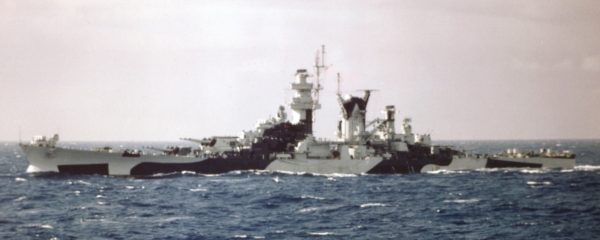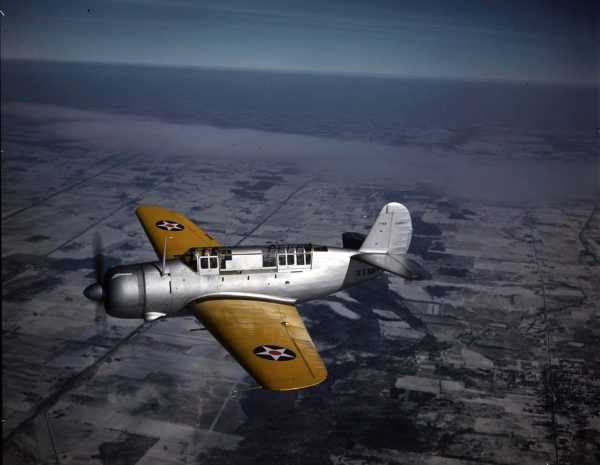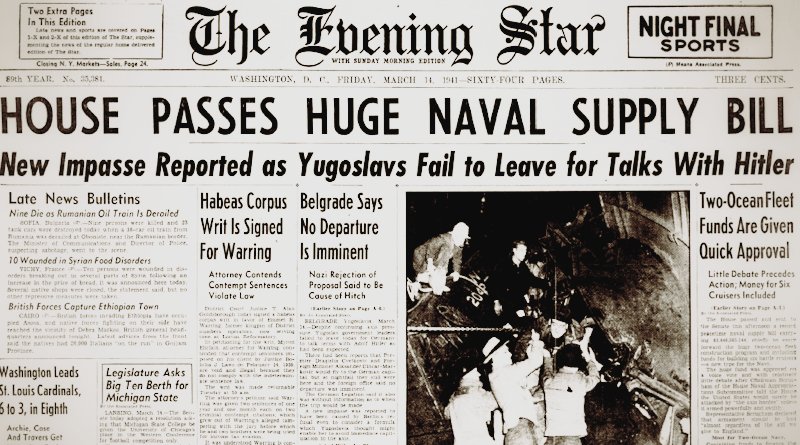World War II Chronicle: March 14, 1941
Click here for TODAY’S NEWSPAPER
Snow soldiers
The skiers pictured on page five are most likely soldiers from the U.S. Army’s 3rd Infantry “The Old Guard,” 62nd Coast Artillery, and 57th Coast Artillery regiments who arrived in Newfoundland in January. These were the first contingent to man what will soon become United States military and Naval bases in Canada and the Caribbean, thanks to the destroyers-for-bases agreement with Britain. Nearly 1,000 officers and soldiers will live aboard the army transport ship Edmund B. Alexander (a captured German passenger liner during the first World War) until Newfoundland thaws out enough to establish a tent city. In June. You can bet that acclimation training and boarding for American soldiers arriving in the Bahamas would have been much more pleasant.
The short-lived battle cruiser
The new class of battle cruiser mentioned on the front page is the USS Alaska-class. Measuring over 800 feet long, these ships will be longer than all United States battleships apart from the Iowa-class.
The keel for USS Alaska (CB-1) is laid down 10 days after the Pearl Harbor attacks and USS Guam (CB-2) begins construction in February. Considering the Navy could build a dozen Fletcher-class destroyers for the money and resources required to build one Alaska-class battle cruiser, three of the six planned battle cruisers are canceled during the war. Hawaii (CB-3) is launched in November 1945 but by then the war is over and work halts shortly afterwards. After numerous ideas to repurpose the ship, such as conversion to an aircraft carrier or mounting ballistic or cruise missiles, Hawaii is eventually towed to Boston where she is broken up for scrap.

The battle cruisers were all constructed by New York Shipbuilding Corporation. New York Ship’s yard — the busiest in the world — sat right across the Delaware River from Philadelphia in Camden, New Jersey.
Helldiver
Page four announces the new Curtiss-Wright SB2 Helldiver, intended to replace the Douglas SBD Dauntless dive bomber. Designers added a longer fuselage and bigger tail after their first prototype crashed last month.

At the controls was Henry Lloyd Child, a former Naval aviator and now chief test pilot for Curtiss-Wright. On Jan. 24, 1939 Child put a Curtiss 75A (a variant of the P-36 Hawk) into a vertical dive during a test flight, and reportedly reached speeds in excess of 575 mph — earning him the title “World’s Fastest Human.” While clocked at an impressive Mach 0.8, Child’s feat wouldn’t count towards the official flight speed record which at the time would belong to the Germans until after World War II ends.
Fédération Aéronautique Internationale air speed record
| Date | Pilot | Speed (mph) | Plane |
|---|---|---|---|
| Sept. 13, 1935 | Howard Hughes | 354.4 | Hughes H-1 (racer) |
| Nov. 11, 1937 | Dr. Hermann Wurster | 379.63 | Messerschmitt Bf 109 |
| March 30, 1939 | Hans Dieterle | 466.6 | Heinkel He 100 |
| April 26, 1939 | Fritz Wendel | 469.220 | Messerschmitt Bf 209 (racer) |
| Nov. 7, 1945 | H.J. Wilson | 606.4 | Gloster Meteor |
Also: Check out “British Give New Hint of Secret Weapon Against Night Raiders” on page three.
Evening star. (Washington, D.C.), 14 March 1941. Chronicling America: Historic American Newspapers. Lib. of Congress.
https://chroniclingamerica.loc.gov/lccn/sn83045462/1941-03-14/ed-1/
